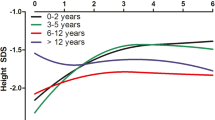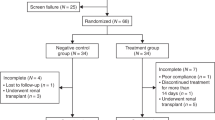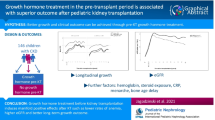Abstract
Experimental findings indicate that sirolimus (SRL) inhibits longitudinal growth by mechanisms potentially related to its inhibitory effects on both cell proliferation and expression of vascular endothelial growth factor (VEGF). The aim of this study was to investigate the growth pattern of kidney-transplanted children treated with SRL in a multicenter observational clinical study. Height, change in height SD (Δ height) and growth velocity of pediatric patients with renal transplant were calculated at 0, 6, 12, and 24 months after starting SRL. Controls of kidney-transplanted children not treated with SRL were matched by age, gender, renal function, and dose of corticosteroids. Sixty-eight children (34 SRL, 34 controls) were enrolled in the study. Nephrotoxicity was the most frequent indication to start therapy with SRL. SRL exerted an adverse effect on growth as demonstrated by significantly lower (p < 0.05) growth velocity (cm/year) and smaller change in height SD in the SRL group after 6 (4.08 vs. 6.56 and –0.05 vs. 0.14), 12 (4.44 vs. 6.11 and –0.03 vs. 0.28) and 24 (4.53 vs. 6.03 and –0.04 vs. 0.53) months of treatment. This study suggests that SRL therapy may interfere with growth of kidney-transplanted children. This undesirable effect needs to be taken into account when considering a switch to SRL and confirmed in further prospective trials including larger number of patients.

Similar content being viewed by others
Abbreviations
- SRL:
-
Sirolimus
- GFR:
-
Glomerular filtration rate
- mTOR:
-
Mammalian target of rapamycin
- VEGF:
-
Vascular endothelial growth factor
- Δ Height:
-
Change in height SD
- CNIs:
-
Calcineurin inhibitors
- rhGH:
-
Recombinant human growth hormone
References
Sehgal SN (2003) Sirolimus: its discovery, biological properties, and mechanism of action. Transplant Proc 35:7S–14S
Hay N, Sonenberg N (2004) Upstream and downstream of mTOR. Genes Dev 18:1926–1945
Guba M, von Breitenbuch P, Steinbauer M, Koehl G, Flegel S, Hornung M, Bruns CJ, Zuelke C, Farkas S, Anthuber M, Jauch KW, Geissler EK (2002) Rapamycin inhibits primary and metastatic tumor growth by antiangiogenesis: involvement of vascular endothelial growth factor. Nat Med 8:128–135
Ibáñez JP, Monteverde ML, Diaz MA, Goldberg J, Turconi AF (2007) Sirolimus in chronic allograft nephropathy in pediatric recipients. Pediatr Transplant 11:777–780
Höcker B, Feneberg R, Köpf S, Weber LT, Waldherr R, Wühl E, Tönshoff B (2006) SRL-based immunosuppression vs. CNI minimization in pediatric renal transplant recipients with chronic CNI nephrotoxicity. Pediatr Transplant 10:593–601
Ibáñez JP, Monteverde ML, Goldberg J, Diaz MA, Turconi A (2005) Sirolimus in pediatric renal transplantation. Transplant Proc 37:682–684
Mota A, Arias M, Taskinen EI, Paavonen T, Brault Y, Legendre C, Claesson K, Castagneto M, Campistol JM, Hutchison B, Burke JT, Yilmaz S, Häyry P, Neylan JF (2004) Sirolimus-based therapy following early Cyclosporine withdrawal provides significantly improved renal histology and function at 3 years. Am J Transplant 4:953–961
Falger JC, Mueller T, Arbeiter K, Boehm M, Regele H, Balzar E, Aufricht C (2006) Conversion from calcineurin inhibitor to sirolimus in pediatric chronic allograft nephropathy. Pediatr Transplant 10:565–569
Mathew T, Kreis H, Friend P (2004) Two-year incidence of malignancy in sirolimus-treated renal transplant recipients: results from five multicenter studies. Clin Transplant 18:446–449
Stallone G, Schena A, Infante B, Di Paolo S, Loverre A, Maggio G, Ranieri E, Gesualdo L, Schena FP, Grandaliano G (2005) Sirolimus for Kaposi's sarcoma in renal-transplant recipients. N Engl J Med 352:1317–1323
Sindhi R (2003) Sirolimus in pediatric transplant recipients. Transplant Proc 35:113S–114S
Alvarez-García O, García-López E, Loredo V, Gil-Peña H, Rodríguez-Suárez J, Ordóñez FA, Carbajo-Pérez E, Santos F (2010) Rapamycin induces growth retardation by disrupting angiogenesis in the growth plate. Kidney Int 78:561–568
Alvarez-Garcia O, Carbajo-Pérez E, Garcia E, Gil H, Molinos I, Rodriguez J, Ordoñez FA, Santos F (2007) Rapamycin retards growth and causes marked alterations in the growth plate of young rats. Pediatr Nephrol 22:954–961
Sanchez CP, He YZ (2009) Bone growth during rapamycin therapy in young rats. BMC Pediatr 9:3
Rangel GA, Ariceta G (2009) Growth failure associated with sirolimus: case report. Pediatr Nephrol 24:2047–2050
Schwartz GJ, Brion LP, Spitzer A (1987) The use of plasma creatinine concentration for estimating glomerular filtration rate in infants, children, and adolescents. Pediatr Clin N Amst 34:571–590
Tanner JM, Marshall WA, Healy MJ, Goldstein H (1983) Assessment of skeletal maturity and prediction of adult height (tw2 method). 2nd edn. Academic Press, New York
Fine RN (2010) Etiology and treatment of growth retardation in children with chronic kidney disease and end-stage renal disease: a historical perspective. Pediatr Nephrol 25:725–732
Nissel R, Brázda I, Feneberg R, Wigger M, Greiner C, Querfeld U, Haffner D (2004) Effect of renal transplantation in childhood on longitudinal growth and adult height. Kidney Int 66:792–800
Grenda R, Watson A, Trompeter R, Tönshoff B, Jaray J, Fitzpatrick M, Murer L, Vondrak K, Maxwell H, van Damme-Lombaerts R, Loirat C, Mor E, Cochat P, Milford DV, Brown M, Webb NJ (2010) A randomized trial to assess the impact of early steroid withdrawal on growth in pediatric renal transplantation: the TWIST study. Am J Transplant 10:828–836
Ferraris JR, Pasqualini T, Alonso G, Legal S, Sorroche P, Galich A, Coccia P, Ghezzi L, Ferraris V, Karabatas L, Guida C, Jasper H (2010) A study on strategies for improving growth and body composition after renal transplantation. Pediatr Nephrol 25:753–762
Li L, Chang A, Naesens M, Kambham N, Waskerwitz J, Martin J, Wong C, Alexander S, Grimm P, Concepcion W, Salvatierra O, Sarwal MM (2009) Steroid-free immunosuppression since 1999: 129 pediatric renal transplants with sustained graft and patients benefits. Am J Transplant 9:1362–1372
Sarwal MM, Vidhun JR, Alexander SR, Satterwhite T, Millan M, Salvatierra O Jr (2003) Continued superior outcomes with modification and lengthened follow-up of a steroid-avoidance pilot with extended daclizumab induction in pediatric renal transplantation. Transplantation 76:1331–1339
Grenda R (2010) Effects of steroid avoidance and novel protocols on growth in paediatric renal transplant patients. Pediatr Nephrol 25:747–752
Tejani A, Fine R, Alexander S, Harmon W, Stablein D (1993) Factors predictive of sustained growth in children after renal transplantation. J Pediatr 122:397–402
Harambat J, Cochat P (2009) Growth after renal transplantation. Pediatr Nephrol 24:1297–1306
North American Pediatric Renal Trials and Collaborative Studies (NAPRTCS) 2008 annual report. Available at: https://doi.org/web.emmes. com/study/ped/annlrept/annlrept.html. Accessed 8 Oct 2009.
Alvarez-Garcia O, Garcia-Lopez E, Loredo V, Gil-Peña H, Rodriguez J, Ordoñez FA, Santos F (2010) Growth hormone (GH) administration improves longitudinal growth in rats with growth retardation induced by rapamycin. Pediatr Nephrol 25:31A
Warshaw BL, Hymes LC (2010) Linear growth in pediatric renal transplant recipients is similar with sirolimus vs. calcineurin inhibitors. Presented at the American Transplant Congress, San Diego (CA) 2010 (abstract).
Acknowledgements
The study was funded by the Instituto de Salud Carlos III from the Spanish Ministry of Science and Innovation and by the Fundación Nutrición y Crecimiento.
Author information
Authors and Affiliations
Corresponding author
Rights and permissions
About this article
Cite this article
González, D., García, C.D., Azócar, M. et al. Growth of kidney-transplanted pediatric patients treated with sirolimus. Pediatr Nephrol 26, 961–966 (2011). https://doi.org/10.1007/s00467-011-1811-3
Received:
Revised:
Accepted:
Published:
Issue Date:
DOI: https://doi.org/10.1007/s00467-011-1811-3




